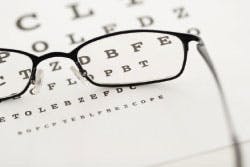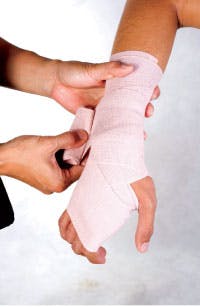Ergonomics bring safety features to an aging laboratory workforce
As clinical laboratories’ “baby boomers” reach
retirement age, many are opting to remain on the job. Some want to
retain their health benefits beyond Medicare. Some have not saved for
retirement and need the money. Some, with their families scattered, are
just lonely and want to stay connected to their extended lab “family” in
the workplace. Regardless of the reason “boomers” choose to stay in the
laboratory environment, lab managers should know that having an
ergonomic plan in place is especially important to the aging workforce.
Provide color contrast in stairs and other changes in
elevation within the laboratory, drawing attention to the change and
making the surface easier to identify. Use primary colors (not pastels)
that are easy for older employees to see. Install non-slip flooring, and
keep walkways free of debris, especially in histology where the build-up
of paraffin can be hazardous.
The ergonomic issue becomes an even greater concern
when age begets injuries. Employers should be aware that aging (poor)
eyesight can cause slips, trips, and falls, which often result in
fractures and lengthy time off the job for older workers. For example, a
60-year-old with degenerative arthritis in her knee who bumps or twists
that knee at work may experience increasing pain with the injury, and
eventually may need a knee replacement. In this situation, determining
eligibility for workers’ compensation could be an urgent issue.
Ergonomic chairs for “creaky” backs
According to the Bureau of Labor Statistics,
employees’ backs are the most frequently cited area of injury on the
body; back problems require the most days away from work. When
organizing older employees’ workstations, avoid having them lift or
reach above shoulder level. Re-design jobs to eliminate physically
challenging laboratory tasks. Use good planning, material-handling aids,
and automation to eliminate manual lifting. In some areas of the
laboratory, 50% to 75% of the time employees perform their duties while
seated, so provide task chairs that have a minimum of four-way (and,
preferably, six-way) adjustability. These are best suited for long-term
seating; the back of chair should be able to move to 110 degrees. In a
slightly reclined position, the chair starts to work for the body,
reducing seated-muscle activity and disc pressure in the lumbar region.
Preventing back injuries that could, potentially,
cause herniated discs is a priority for employers not only faced with
rising workers’ compensation costs and reduced productivity but also
with the additional challenges attributable to older workers.
Sight for sore eyes
Computer-vision syndrome or CVS is the result of
spending long hours working at a computer terminal. Some common symptoms
may include eyestrain; blurred vision; dry, irritated eyes; double
vision; and headaches. The top of a monitor screen should be at eye
level and directly in front of the user, with a distance from his eyes
and the screen of between 18 and 26 inches. Screens that swivel
horizontally, tilt, or elevate vertically are ideal because they allow
the monitor to be moved into a comfortable viewing angle, as well as to
avoid glare, for the user. Adjustable screens are helpful for employees
who wear bifocals.
Employees on the night shift have an increased risk of cardiovascular disease, gastrointestinal disorders, obesity, diabetes, and sleep apnea. They are also prone to increased absenteeism, turnover, and on-the-job injuries such as needle sticks and technical errors.
According to Jeffrey Anshel, optometrist and author
of Visual Ergonomics in the Workplace, using a monitor too close
to the eyes can contribute to “nighttime blindness.” This condition
makes focusing at regular or faraway distances difficult after a long
day of up-close reading. As scary as that sounds, it is very easy to
prevent. Here is what users can do:
- Lower the computer monitor, and tilt the screen upward, allowing the eyes a more natural focus for reading.
- Practice the 20/20/20 rule. Every 20 minutes, take 20-second break to focus on a spot 20 feet away. This practice gives a user’s eyes a break by allowing them to readjust to distances beyond the screen.
- Follow the “three Bs” to lower user stress levels:
- Take frequent Breaks;
- Concentrate on Blinking to moisturize the eyes; and
- Remember to Breathe
Newfangled eyewear for aging eyes
Encourage employees to visit eye care professionals
regularly, and have them inform their optometrist or ophthalmologist of
computer-related work. Visual symptoms may occur due to prescription eyewear
that is not designed for computer use. Computer glasses can make a world of
difference in comfort level while aging workers are using a computer. These
glasses can correct blurred vision and relieve symptoms such as eyestrain
and burning. Most people wear glasses or contact lenses that do not correct
the intermediate zone at all. Reading glasses correct near-vision only, and
bifocals correct only near and far vision. Even lenses that do
correct the intermediate zone, such as trifocals and progressive lenses,
have only a small portion for the intermediate area — not nearly large
enough for comfortable computer work. Users without appropriate eyeglasses
may try to compensate for blurred vision by leaning forward or by tipping
their heads back to look through the bottom portion of their glasses. Both
of these actions can result in sore necks, sore shoulders, or sore backs.
Utilizing desktop software applications that enlarge the contents on the
screen also makes reading easier and reduces eyestrain.
Lights, tasks, action!
As employees age, proper workplace lighting becomes
important. Ambient light or natural light can be used when it is available —
and task lighting should be no more than three times brighter than ambient
light. To deflect or eliminate direct light, reflected light, or intense
sunlight, shades and awnings for laboratory windows can be used. Turning off
overhead lights or removing some fluorescent bulbs can also reduce too
bright a light. (In a four-bulb light fixture, remove the middle two, if
possible.) Diffusers on light sources can decrease glare, as can flat-screen
computers. Indirect lighting — particularly with several low-powered and
adjustable sources — is a good method for increasing illumination while
controlling or reducing harmful glare.
Repeat after me
Frequent breaks and changes of position may help avoid
repetitive-motion problems such as carpal-tunnel syndrome or CTS. Instead of
a 15-minute break every four hours try a five-minute “mini-break” every hour
to allow stretching of the hand, wrist, and forearm muscles. CTS is one of
the most common job-related injuries and, if not properly treated, can cause
irreversible nerve damage and permanent disability of varying degrees —
especially in phlebotomists and transcriptionists. Repetitive-motion
injuries can also occur during routine procedures such as pipetting, working
at microscopes, operating microtomes, and using cell counters. Allow older
workers to adopt these mini-breaks as routine. And use caution when placing
older workers in jobs requiring operation of equipment with which they are
not familiar. If this cannot be avoided, then proper training is a must;
give them extra time to adjust to the change.
Rockin’ around the clock
Another under-reported issue occurs in laboratories that
operate 24 hours a day. According to a 2004 study by Circadian Technologies
in Stoneham, MA, employees on the night shift have an increased risk of
cardiovascular disease, gastrointestinal disorders, obesity, diabetes, and
sleep apnea. They are also prone to increased absenteeism, turnover, and
on-the-job injuries such as needle sticks and technical errors.
Provide color contrast in stairs and other changes
in elevation within the laboratory, drawing attention
to the change and making the surface easier
to identify. Use primary colors (not pastels)
that are easy for older employees to see.
In a 2006 study published by the American College of
Occupational and Environmental Medicine, 38% of night-shift employees
experience low levels of energy, poor sleep, or feelings of fatigue. The
study reported that fatigue was more common in women than men, in workers
over the age of 50, and in jobs with decision-making responsibility.
Employees with fatigue averaged 5.6 lost hours per week.
The National Institute of Occupational Safety and Health
suggests that 20 minutes of aerobic exercise before work can help
employees wake up, feel energized, and keep their hearts in shape. Lab
managers can encourage employees to get exercise and can counter some of the
effects of aging by implementing wellness programs. Older employees (in
fact, all employees) can improve their health by engaging in as
little as 30 minutes of moderate activity each day.
End notes
Finally, talk to your mature staff members, ask them what
can be done to make their jobs more comfortable, and get their feedback. For
example, while music is pleasant to many, it may be distracting for an older
worker; minimize equipment and background noise in the lab. Remember, too,
avoid making older employees perform strenuous work in hot and/or humid, or
cold environments. As people age, their skin becomes thin, less resilient,
and susceptible to bruising. Often, aging workers will have a simple,
easy-to-adapt solution that will help them as well as others in the
laboratory, work under lab-wide safe conditions.
Best-selling author, professional speaker, and safety
consultant Terry Jo Gile, MA Ed, MT(ASCP), The Safety Lady, has helped
thousands of laboratorians create safety-savvy laboratories. Her book,
Complete Guide to Laboratory Safety – Second Edition, is the safety
reference tool specific to clinical laboratories. Contact her at
www.safetylady.com . Subscribe to Safety Savvy, her monthly
e-newsletter, at
http://visitor.constantcontact.com/email.jsp?m=110195699369 .



